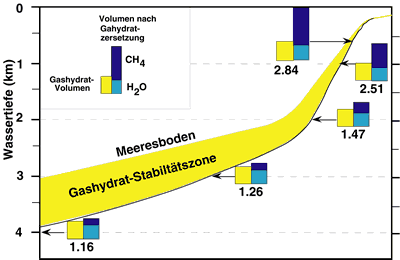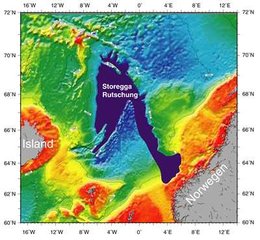Page path:
- General/Marine Geology
- Gas Hydrate Research
- Stability of Submarine Slopes
Stability of Submarine Slopes
When enclosed in sedimentary pore space, gas hydrate acts like cement, compacting and stabilizing the seafloor. However, if formed in deposits that are still unconsolidated, gas hydrate prevents the normal increase of compaction with increasing lithostatic pressure.
If exposed to variations in pressure and/or temperature, interstitial gas hydrate decomposes. In this case, the compactness of the seafloor decreases and may cause submarine land slide. Seismic, bathymetric and side-scan sonar mapping of the seafloor has shown that slides of different order of magnitude characterize all continental slopes.
If exposed to variations in pressure and/or temperature, interstitial gas hydrate decomposes. In this case, the compactness of the seafloor decreases and may cause submarine land slide. Seismic, bathymetric and side-scan sonar mapping of the seafloor has shown that slides of different order of magnitude characterize all continental slopes.

Picture:
Thickness of the zone of gas hydrate stability in the seafloor (assuming a geothermal gradient of 30°C/km) depending on water depth (bold line). The bar charts show the equally depth-dependent increase in volume (number = factor by which the volume increases) if a given volume of gas hydrate dissociates (according to Paull et al., 2000).
Thickness of the zone of gas hydrate stability in the seafloor (assuming a geothermal gradient of 30°C/km) depending on water depth (bold line). The bar charts show the equally depth-dependent increase in volume (number = factor by which the volume increases) if a given volume of gas hydrate dissociates (according to Paull et al., 2000).
There is hardly any immediate evidence for submarine slides triggered by gas hydrate dissociation. Still, the hypothesis seems to be corroborated by some observations. For instance, near slide scars traces of gas and fluid flux that move upward along seismically registered paths can often be found. The seafloor itself shows crater-like depressions, so-called pockmarks, or bivalve and microbial mats that indicate fluid seepage (cold seeps). At the upper shelf edge there are slopes of more than 4°. Gravitational slides appear likely if such a slope becomes less stable due to gas hydrate dissociation. One important factor seems to be the expansion of the released gas, which increases with decreasing water depth. For example, at 650 m water depth, the volume of released gas and water is almost three times the original gas hydrate volume. Gas hydrate decomposition at the upper shelf edge thus results in an enormous pore pressure that leads to a massive loss of compactness while the large pore space makes the sediment highly deformable. Zones represented by bottom simulating reflectors, with their slope-parallel trend, are another potential factor triggering submarine slides. When gas hydrate dissociates, they can create weak layers parallel to the slope.
Gas hydrate dissociation at the upper shelf edge can be caused by reduced pressure due to a lower sea level. During the Last Glacial Maximum (LGM), 18,000 years ago, the global sea level was approximately 120 m lower than at present. This should have led to gas hydrate dissociation and, subsequently, to destabilization of the upper shelf edge. Many slides indeed happened during this period or later. However, they may also have been caused by higher sedimentation rates at the continental slope.
Gas hydrate dissociation at the upper shelf edge can be caused by reduced pressure due to a lower sea level. During the Last Glacial Maximum (LGM), 18,000 years ago, the global sea level was approximately 120 m lower than at present. This should have led to gas hydrate dissociation and, subsequently, to destabilization of the upper shelf edge. Many slides indeed happened during this period or later. However, they may also have been caused by higher sedimentation rates at the continental slope.

Picture:
The mass moved by the Storegga slide had a total volume of 5,608 km3. It is the largest submarine slide known so far. It took place in several stages, starting about 7,000 years ago. The most massive mass movement happened during the first slide which triggered a tsunami. Depending on coastal morphology and population density, such a tsunami could nowadays cause severe damage.
The mass moved by the Storegga slide had a total volume of 5,608 km3. It is the largest submarine slide known so far. It took place in several stages, starting about 7,000 years ago. The most massive mass movement happened during the first slide which triggered a tsunami. Depending on coastal morphology and population density, such a tsunami could nowadays cause severe damage.


